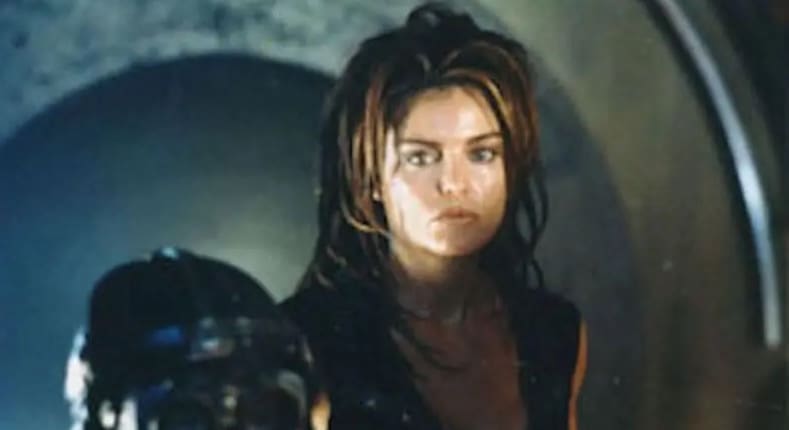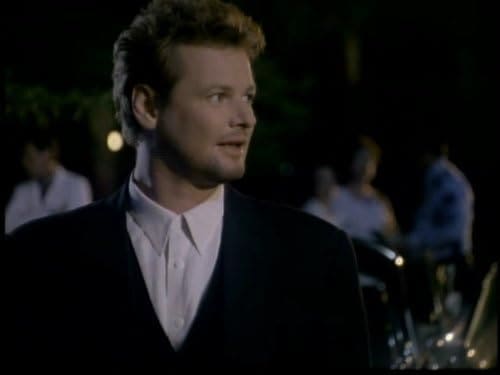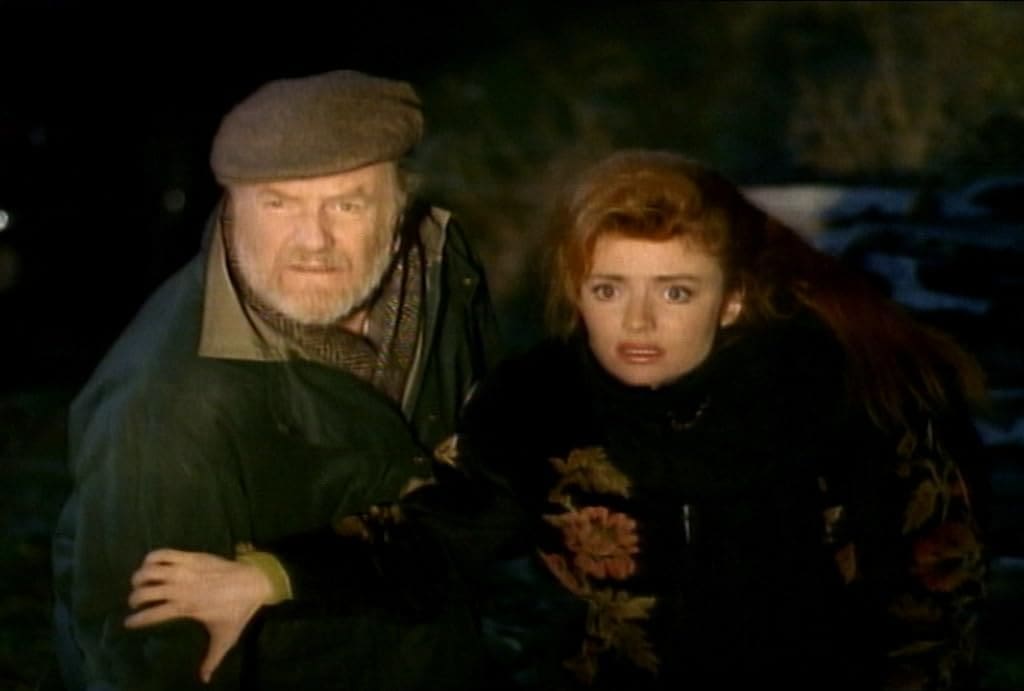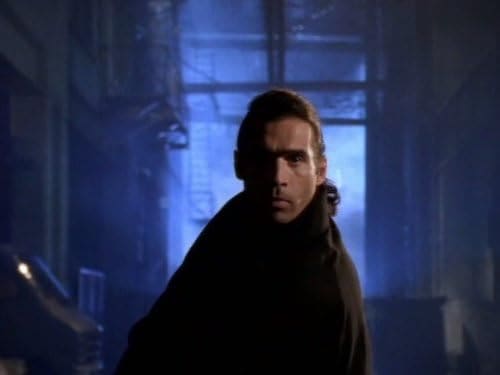
When the Nineties arrived the cable TV rules changed. There were now sixty channels, and they were hungry for new content. This allowed for some great urban fantasy TV shows which were never possible before. Here, I present the Top 5 which you may not remember.
The baseline rule for these new shows was that they had to be as cheap as dirt. Now today, there are plenty of cheap shows that come and go constantly, and you might not have heard about one until it had been out of production for years. That wasn’t the case in the Nineties. Sixty channels were few enough to make it difficult to avoid at least skimming across something new and different when you were channel surfing.
Nineties shows were indeed cheap, which meant they had to be shot anywhere but Los Angeles. The benefit of that was that different locations brought some fresh perspectives. They were clearly different from anything coming out of Hollywood. Admittedly, they weren’t very good by modern standards, but there was a sort of charm to them. And when all is said and done, they were trying their best.
My requirement for this list is that the show had to be more or less forgotten, and it had to be urban fantasy. So, none of the Star Trek series qualify, nor does Babylon 5. Buffy is disqualified because while it is urban fantasy, it was on a broadcast network, and it is in no way forgotten.

1. She-Wolf of London:
She-Wolf of London used a title from a classic horror movie and repurposed it. The intent was to remind you of An American Werewolf in London but instead of the Doctor Pepper Guy, it starred a woman.
Randi Wallace began as an American grad student studying in London. She was mousy and theoretically unattractive. Which is to say she wore glasses and had neatly mussed hair. After she gets nipped by a werewolf she became super hot because she lost the glasses and started wearing heavy Eighties style makeup, (the show was shot in 1990, so Eighties fashions weren’t dead yet).
She-Wolf and Professor-Boyfriend would investigate supernatural occurrences each week. It was a rom-com and it worked well enough as that.
The show was funded by Universal as part of its Hollywood Premiere Network, which was one of the me-too shake&bake networks like PTEN that cropped up after it was clear that FOX was not a failure.
She-Wolf of London actually managed to get a second season but tragically, the series was relocated to Los Angeles, and that just ruined it.

2. Forever Knight:
Before there was Netflix and chill, there was Forever Knight. The chicks absolutely loved this one. It was incredibly emo in every way available to it. And it was the very first of the sad vampire shows.
Nick Knight was a detective in the Toronto police force. He worked the graveyard shift because of a rare skin disorder which made him react badly to sunlight. In reality, he was an 800-year-old vampire who was very remorseful over the whole centuries of slaughter and blood-slurping thing. He is trying to find a way out of being a vamp and back into the light. His maker LaCroix thinks the whole project is ridiculous but after 800 years he’s attached to Nick.
A typical episode would have Nick work a case, then he would be reminded of something that happened centuries ago and the B story would take place in the flashbacks (put a pin in that one, we are circling back to it).
This series almost didn’t qualify because it was originally a network show, it was on CBS for all of one year. Then it got canceled and picked up by USA network.
Forever Knight did well enough that it was worth a few tie-in books and if you dig deeply enough into the $1 long boxes you might find an issue or two of its comic book run. The show lasted for a grand total of three seasons, which was pretty good for a nineties urban fantasy show.
It ended when Nick finally gave up the struggle and handed LaCroix a wooden stake. You were supposed to fill in the blanks with your imagination.

3. Friday the 13th, the Series:
So, you would get a big dose of Jason once a week? A loyal Darkling asks, Cool!
Ha! Ha! Ha! The Dark Herald answers. Not even a little bit.
The resemblance to the Friday the 13th movies began and ended with the title. No Jasons in this one. Originally the show was titled The 13th Hour but the producer changed it because “Friday the 13th” can’t be legally trademarked, and it might chump a few fans of Jason into giving it a look.
I know I did.
And yes, I admit it, this show is pretty much a Nineties show in name only. It started in 1987 and ran until 1990. However, it was always playing in the Nineties.
RELATED: Leak Of Marvel’s Echo And Daredevil Fight Scene From Disney+ Show Leaves Fans Shocked And Dismayed
The premise, however, was good enough. Louis Vendredi (yes, that is indeed “Friday” in French) made a deal with the devil for the usual Faustian goodies of wealth, magic, and immortality. In exchange, he would sell cursed antiques out of his shop. But then Louis broke the pact and the devil collected his due.
Louis’ niece and nephew inherited the shop and since neither wanted to get into the antique business they started selling the stock at fire-sale prices. Then Louis’ mortal opponent Jack Marshak shows up and tells them that they have been selling cursed goods and they have to get them back. Being good Gen-Xers they don’t sob, “I don’t wanna!!! What about m-e-e-e?!?!” They just roll up their sleeves and get to work cleaning up the mess left by an irresponsible previous generation.
The accursed antiques in question are indestructible, so the only way to neutralize them is to lock them up in a magic vault beneath Louis’ shop, Curious Goods. Also, the objects can only be activated by murdering someone. Although, the antique would usually contrive to give its would-be victim an accidental freebie, “Oh no! My nurse just accidentally impaled herself on that glowing black obelisk I got from the antique shop. Now, I’m suddenly ten years younger and can walk again. Hmm.” So often as not, the Gen-X Scooby Gang would be up against someone who knew perfectly well the item was cursed and was willing to kill to keep it.
Occasionally, Louis would try to escape from Hell and get back to the mortal world. Those were the best episodes.
The star of the show was a girl who was only credited as Robey. The single-name thing really didn’t work for her. After the show was axed, she did one Shannon Tweed-type straight-to-video softcore role, then she suddenly remembered her first name was Louise and married an Earl. Good for you Robey!
It wasn’t a bad little horror show by the standards of its day. I wouldn’t say it’s still worth a watch because none of these shows are. But it was usually playing in the old Monster Chiller Horror Theater timeslot of 10:30 on a Saturday night and if there wasn’t a party to go to that night it killed the time. Usually, it was followed by War of the Worlds but that’s a different listicle.

4. Highlander the Series:
Okay, forget what I just said about these shows not being worth watching anymore.
And I know I said. ‘forgotten series,’ but this one is kind-a, sort-a forgotten in that nobody likes to think about it.
The reason for that is that it massively overstayed its welcome.
However, when the show was new, there were a few years when the sound of Freddie Mercury singing out, “Here we are! Born to be kings! We’re the princes of the uni-vers-se!” Was enough to get me to drop whatever I was doing, and glue myself to the lobotomy box for an hour without fail.
The original Highlander was a decent enough Eighties urban fantasy film. However, it left absolutely no room for a sequel. Connor Macleod was the last Immortal at the end of the movie. Then came Highlander II which was The Last Jedi of the Highlander franchise. But it did seem to work as a functional reset because everybody was so determined to forget everything about that movie, that we also sort of forgot that there shouldn’t be any more Highlander films.
Through some kind of bizarre Hollywood alchemy, Highlander was pitched as a TV series and greenlit in 1992. Christopher Lambert was too big of a star (at that time) to be in a cheap cable TV show, so the producers hired Adrian Paul. Now Paul could actually do a Scottish accent, and astonishingly, he was a fairly decent swordsman, and martial artist. Most shocking of all, he could also act. On top of all that he looked like he fell off the cover of a bodice-ripping, romance novel.
Honestly, Paul should have been a much bigger star than he ever became.
The first season was truly excellent. It was everything the films could have been and just weren’t. The pain of a man who couldn’t die but everyone he loved would, was evident in everything he did. His biggest problem, of course, was that the only people he knew that wouldn’t die either were sooner or later going to come for his head.
Like the Forever Knight, this series followed the formula of a contemporary (A) story, with a concurrently running (B) story that was told in flashback. In the first season, they didn’t bother with a duel every week. The stories just didn’t need it. It got by just fine with contemporary drama intercut with a period piece drama. That meant that when he had to draw the katana it was special. Part of the funding came from a French film company, so half any season was always spent in France.
Sadly, in the following seasons, the formula did indeed turn into a duel of the week. The writing was still good enough but there were clouds on the horizon. Eventually, the French dropped out which seemed to significantly lower the show’s standards for some reason. Most of these urban fantasy shows took their final bow before you could get tired of them. Not so, with Highlander the series. It went on for a hell of a lot longer than it should have. The scripts became extremely formulaic and repetitive. When they tried to up their game, it made things so much worse (The Four Horsemen comes irresistibly to mind). There was an attempt to spin off the series with Highlander the Raven, which starred a girl Immortal. Guess what didn’t sell with an audience that licked their lips whenever the tall guy with black hair took his shirt off?
Finally, the series was ended when the franchise’s movie producers decided that Adrian Paul should take over for Christopher Lambert, (who was aging pretty badly for an Immortal), in the films.
Highlander: Endgame, was just that. It killed the franchise. The script was even weaker than the TV shows and they were pretty damn weak by then. Worse still, the villain was just corny beyond belief.
Seven years later there was a made-for-Sci-Fi Channel movie, Highlander: the Source, that was supposed to reboot the series. It went nowhere.
Immortal, the Highlander wasn’t.
Let’s hope Henry Cavil can make the next reboot work.

5. The Secret Adventures of Jules Verne:
Steampunk is urban fantasy’s special needs, little brother. And so, rounding out the end of this list is the only example of steampunk from the Nineties that I can think of.
The Secret Adventures of Jules Verne looked promising at first. The premise looked fun. Jules Verne’s writings were based on actual adventures he’d had as a young man. Phileas Fogg and Passepartout were both real people. Their enemy was a terrorist organization called the League of Darkness that was using steampunk tech to try and take over the world. Verne and company flew into battle against them in the luxury airship, Aurora.
The acting was good, the performers were bringing the goods. While Jules Verne was the title character, Phileas Fogg was the actual lead. He was played by Micheal Praed. If you remember him at all, it is more likely as Robin Hood in the 1980s TV version. He was somebody else who should have had a better career, but he made a couple of bad calls when he was first making waves as Robin Hood.
However, the appearance of the show was a little odd. It was one of the very first shows to be shot exclusively on HDTV and the technology was still in diapers. The props were cheap, and the primitive HDTV required very cramped sets. The end result gave the appearance of something you would see in a theatrical play.
I’m afraid the plots weren’t all that much better than The Wild Wild West. Although at 22 episodes in its first and only season, it has almost as many shows as Jodie Whitaker’s entire run as Doctor Who. And frankly, any show on this list is more entertaining than that.
Jules Verne’s ultimate problem was that it was clearly treading a path that was a little too well-trodden by 2000.
All good things must come to an end. And for that matter so must all indifferent things. Nineties urban fantasy cable TV ended not with a bang but a whimper.
The decade was coming to an end and the cable TV selection of channels was drastically expanding. The Science Fiction channel had morphed into the Sci-Fi channel and cable TV was starting to produce original content that actually had a budget.
After 9-11 there wasn’t much of a need for fake monsters anymore. So, a genre faded from our screens and then from our minds with the passing of years. But now and then when cruising around YouTube, I’ll find something from a simpler age that puts a smile on my cranky old face.
There may be other urban fantasy tv shows that are so forgotten I forgot about them completely. If you have a favorite, leave it in the comments below.
NEXT: Clownfish TV’s Kneon Reveals Mainstream Media Plot To Push Polyamory On Teen Girls

Every Saturday night I would watch Highlander TV show with my dad, we never missed an episode.
Good times